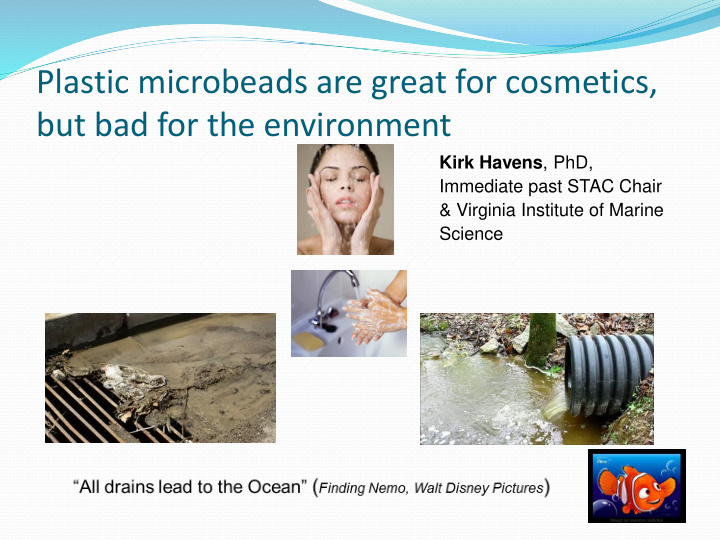



Plastic microbeads are great for cosmetics, but bad for the environment Kirk Havens , PhD, Immediate past STAC Chair & Virginia Institute of Marine Science
Why are there microbeads in cosmetics? • Improved Feel >100µm • Optical Blurring (Hide wrinkle lines)
This is a problem because…. Tube worms Shore birds Blue Crab Microplastics Mussels Zooplankton Microplastics: • can adsorb chemicals that are in the water • release previously bound-up chemicals into Turtle Striped Bass the water as they breakdown • readily take up PCBs and DDTs • can introduces toxins into the food chain • create obstructions that keep the organisms from taking in enough food, leading to malnutrition or starvation
STAC expert panel
Microbead-Free Waters Act of 2015 (1) The manufacture or the introduction or delivery for introduction into interstate commerce of a rinse-off cosmetic that contains intentionally-added plastic microbeads. (2) (A) the term ‘plastic microbead ’ means any solid plastic particle that is less than five millimeters in size and is intended to be used to exfoliate or cleanse the human body or any part thereof; and (3) ( B) the term ‘rinse - off cosmetic’ includes toothpaste.” ____________________________________________________________ U.S. House approves bill to ban plastic microbeads (Unanimously – December 7 th , 2015) U.S. Senate passes ban on plastic microbeads (Unanimously – December 18 th , 2015) President Obama Signs Ban on Plastic Microbeads (December 28, 2015) Wow…. Through the US Congress & signed by the President in 21 days …
Take home points from STAC Expert Panel Report. Federal legislation has raised awareness of the problem of microplastics in the form of microbeads Federal legislation doesn’t address all microbeads (rinse off only) or microplastics (fragmented larger plastics, microfibers) – need proper definitions (i.e. biodegradation, plastic, polymer) – Scientific community can help define. Research need on sources of microplastics Research need on ecotoxicology – what happens to animals that ingest particles Preventative measures to keep plastic out of waterways and wastewater stream – removal shouldn’t be placed solely on WWTPs. Promotion of truly biodegradable polymers – allow for industry and business innovation Tracking and monitoring of additives in plastics that can end up in marine environments *State or regional marine debris reduction plans – Mid Atlantic Marine Debris Reduction Plan – partnership with NOAA’s Marine Debris Program
Around 70-80% of marine debris is land- based And between 60-80% of that is plastic…
Alternatives are already developed
American Lobster Stone Crab Spiny Lobster
STAC expert panel
Questions?
Recommend
More recommend